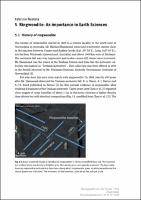Chapter 5 Ringwoodite
its importance in Earth Sciences
Author(s)
Nestola, Fabrizio
Contributor(s)
Armbruster, Thomas (editor)
Micaela Danisi, Rosa (editor)
Collection
European Research Council (ERC); EU collectionLanguage
EnglishAbstract
The history of ringwoodite started in 1869 in a remote locality in the south-west of Queensland in Australia. Mr. Michael Hammond witnessed a meteorite shower close to the junction between Cooper and Kyabra Creeks (Lat. 25° 30S., Long. 142° 40E.),not far from Windorah (Queensland, Australia) and about 1000 km west of Brisbane. The meteorite fall was very impressive and in due course 102 stones were recovered. Mr. Hammond was the owner of the Tenham Station and from this the meteorite collection was named as “Tenham meteorites”. This collection was then offered in 1935 to the British Museum by Mr. Benjamin Dunstan, formerly Government Geologist of Queensland.
Keywords
Crystallography; Mineralogy; Quasicrystal; Ringwoodite; NanocrystalDOI
10.1515/9783110417104-007ISBN
9783110417043; 9783110417210OCN
1135845499Publisher
De GruyterPublisher website
https://www.degruyter.com/Publication date and place
Berlin/Boston, 2015Grantor
Classification
Condensed matter physics (liquid state and solid state physics)
Crystallography
Chemistry of minerals, crystals and gems
Earth Sciences, Geography, Environment, Planning
Materials science


 Download
Download